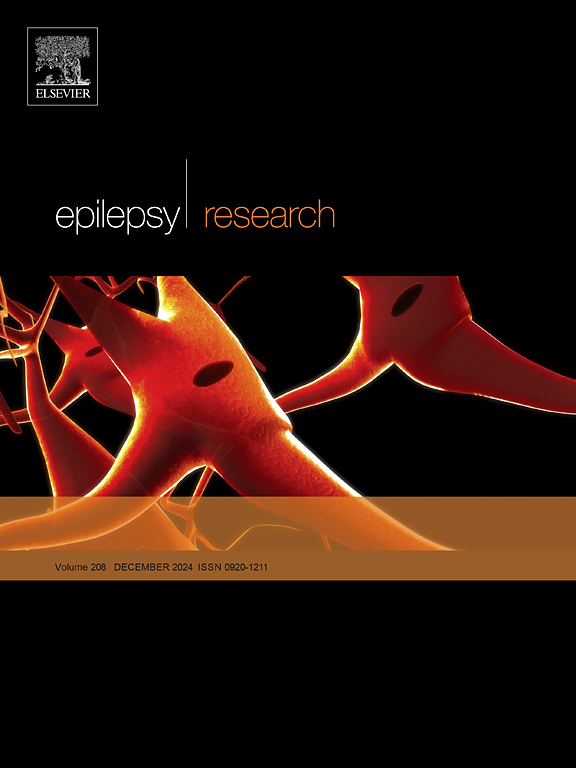High density probes reveal medullary seizure and rapid medullary shutdown in a model of fatal apnea in seizure
IF 2
4区 医学
Q3 CLINICAL NEUROLOGY
引用次数: 0
Abstract
Objective: Sudden unexpected death in epilepsy (SUDEP) is suggested to be a cardiorespiratory collapse that occurs shortly after a seizure. The impacts of seizure on medullary respiratory control remain poorly understood. Prior work in rats suggests that reflexive apneas are highly fatal during seizure but well tolerated otherwise. These reflexes share network connectivity in the medulla, particularly the caudal solitary nucleus (NTS) and ventral respiratory column (VRC), and possibly other intermediate structures. We sought to observe the activity in these regions in fatal ictal apneas. Methods: We collected data from urethane anesthetized long evans rats. To record neural activity we used either 125 µm silver wire in the caudal NTS or a Neuropixel 1.0 probe along a dorsoventral trajectory that spanned the caudal NTS to the VRC. We additionally recorded cardiorespiratory activity via several methods. We induced a reflexive apnea – the diving reflex – by nasal irrigation of cold water for several seconds, which produces a period of apnea, then gasping, and then a gradual return to eupnea. We repeated several trials while the animal was healthy and subsequently induced continuous seizure activity with kainate and repeated the reflexes, which are ultimately fatal during seizure. Results: Seizure activity confounds many established methods of analyzing high-density single unit data such as provided by Neuropixels probes, and so our analyses focus on averaging responses over larger anatomical regions (120 µm) covering small populations of neurons. Seizure produces broad increases in neuronal activity across the medullary tract, which by itself is not dangerous. Ictal reflexive apneas were broadly more inhibitory (producing a reduction in firing rate) than they were preictally, and fatal ictal responses resulted in a very rapid shutdown of all medullary activity. We only rarely observed ictal central apneas (apneas with no apparent stimuli), but when we did they were apparently safe, always survived, and produced no significant change in network activity (neither increase nor decrease). Conclusions: These data support the theory that central apnea events in seizure are relatively safe as we observed they produce little change in the medullary tract network, while stimuli-induced-reflexive-apneas are dangerous because they produce profound quieting across respiratory centers. Our data suggest that seizure spreads to this medullary tract at approximately the same rate and intensity as forebrain, as previously described in this model. These data are supportive of SUDEP mechanisms involving brainstem inhibition as a primary cause, such as spreading depolarization waves. These findings likely extend beyond nasal irrigation to any sensory reflexive apnea caused by airway irritation of any kind, and may bear relevance to similar deaths seen in infants.
高密度探针显示致命呼吸暂停发作模型中的髓质发作和髓质快速关闭
目的:癫痫猝死(SUDEP)被认为是癫痫发作后不久发生的心肺衰竭。癫痫发作对髓质呼吸控制的影响仍然知之甚少。先前对大鼠的研究表明,反身性呼吸暂停在癫痫发作期间是高度致命的,但在其他情况下耐受性良好。这些反射在髓质,特别是尾侧孤立核(NTS)和腹侧呼吸柱(VRC),以及可能的其他中间结构中共享网络连接。我们试图观察致死性呼吸暂停时这些区域的活动。方法:收集聚氨酯麻醉的长evans大鼠的数据。为了记录神经活动,我们在尾侧NTS中使用125 µm的银线,或者沿着背侧轨迹沿着横跨尾侧NTS到VRC的Neuropixel 1.0探针。我们还通过几种方法记录了心肺活动。我们用冷水鼻腔冲洗几秒钟,诱导反射性呼吸暂停——潜水反射,这产生一段时间的呼吸暂停,然后喘气,然后逐渐恢复到呼吸暂停。我们在动物健康的情况下重复了几次试验,随后用kainate诱导了持续的癫痫发作活动,并重复了最终在癫痫发作期间致命的反射。结果:癫痫活动混淆了许多已建立的分析高密度单单元数据的方法,例如由Neuropixels探针提供的数据,因此我们的分析重点是在覆盖小群体神经元的较大解剖区域(120 µm)上平均反应。癫痫发作会使整个髓束的神经元活动广泛增加,这本身并不危险。发作性反射性呼吸暂停比预期更具有抑制作用(产生放电率降低),致命的发作性反应导致所有髓质活动非常迅速地停止。我们很少观察到中枢呼吸暂停(没有明显刺激的呼吸暂停),但当我们这样做时,它们显然是安全的,总是存活下来,并且网络活动没有显著变化(既没有增加也没有减少)。结论:这些数据支持这样的理论,即癫痫发作时的中枢性呼吸暂停事件相对安全,因为我们观察到它们在髓束网络中产生很少的变化,而刺激诱导的反射性呼吸暂停是危险的,因为它们在呼吸中枢产生深度平静。我们的数据表明,癫痫发作以与前脑大致相同的速度和强度扩散到这个髓束,正如之前在这个模型中所描述的那样。这些数据支持涉及脑干抑制作为主要原因的猝死机制,如扩散去极化波。这些发现可能不仅适用于鼻腔冲洗,也适用于由任何类型的气道刺激引起的任何感觉反射性呼吸暂停,并且可能与在婴儿中看到的类似死亡有关。
本文章由计算机程序翻译,如有差异,请以英文原文为准。
求助全文
约1分钟内获得全文
求助全文
来源期刊

Epilepsy Research
医学-临床神经学
CiteScore
0.10
自引率
4.50%
发文量
143
审稿时长
62 days
期刊介绍:
Epilepsy Research provides for publication of high quality articles in both basic and clinical epilepsy research, with a special emphasis on translational research that ultimately relates to epilepsy as a human condition. The journal is intended to provide a forum for reporting the best and most rigorous epilepsy research from all disciplines ranging from biophysics and molecular biology to epidemiological and psychosocial research. As such the journal will publish original papers relevant to epilepsy from any scientific discipline and also studies of a multidisciplinary nature. Clinical and experimental research papers adopting fresh conceptual approaches to the study of epilepsy and its treatment are encouraged. The overriding criteria for publication are novelty, significant clinical or experimental relevance, and interest to a multidisciplinary audience in the broad arena of epilepsy. Review articles focused on any topic of epilepsy research will also be considered, but only if they present an exceptionally clear synthesis of current knowledge and future directions of a research area, based on a critical assessment of the available data or on hypotheses that are likely to stimulate more critical thinking and further advances in an area of epilepsy research.
 求助内容:
求助内容: 应助结果提醒方式:
应助结果提醒方式:


